wikiHow is a “wiki,” similar to Wikipedia, which means that many of our articles are co-written by multiple authors. To create this article, 146 people, some anonymous, worked to edit and improve it over time.
This article has been viewed 1,869,871 times.
Learn more...
What can you do if you slip off a scaffolding 10 stories above the ground, or find yourself free falling when your parachute fails? The odds are not on your side, but survival is possible. If you can keep your wits about you, there are ways you may be able to influence the velocity of your fall and lessen the ultimate force of the impact.
Steps
Strategy for Surviving a Fall from Several Stories
-
1Grab an object on your way down. If you can manage to grab a large object, such as a plank or a piece of rafter, you'll greatly increase your chances of survival. The object will absorb some of the impact when you land, taking a little stress off of your bones.[1]
-
2Try to break your fall into parts. If you're falling next to a building, or off a cliff in the wilderness, do your best to break your fall into segments by hitting a ledge, a lower cliff, a tree, or another object. This breaks up the momentum of your fall and divides it into several shorter falls, which gives you a much better chance of surviving.Advertisement
-
3Relax your body. If your knees and elbows are locked and your muscles are rigid, the impact of the fall will do more harm to your vital organs. Don't hold yourself stiff. Do your best to relax your body so that when you hit the ground your body is more easily able to take the impact.
- One way to remain (relatively) calm is to focus on performing the steps that lead to greater survival rates.
- Stay aware of your body, moving your arms and legs to make sure they aren't locked.
-
4Bend your knees. Possibly nothing is more important to surviving a fall (or simpler to do) than bending your knees. Research has shown that having one's knees bent at impact can reduce the magnitude of impact forces 36-fold. However, do not bend them too far - only keep a slight bend so they are not locked.
-
5Land feet-first. No matter what height you fall from, you should always try to land on your feet. Landing feet-first concentrates the impact force on a small area, allowing your feet and legs to absorb the worst of the blow. If you are in any other position, try to right yourself before you hit the ground.
- Fortunately, attaining the feet-first position seems to be an instinctive reaction.
- Keep your feet and legs tightly together so that both your feet hit the ground at the same time.
- Land on the balls of your feet. Point your toes slightly down before impact so that you will land on the balls of your feet. This will allow your lower body to more effectively absorb the impact.
-
6Try to fall to the side. Once you land on your feet, you will fall either to the side, front or back. Try to avoid falling on your back. Falling to the side is statistically best. If you can't manage that, try to fall forward instead, breaking your fall with your arms.
-
7Protect your head for when you bounce. When you fall from a great height onto land, you will usually bounce. Some people who survive the initial impact (often with a feet-first landing) suffer a fatal injury on their second impact. You will most likely be unconscious when you bounce. Cover your head with your arms by placing your arms on the sides of your head with your elbows facing forward (and projecting in front of your face), and your fingers laced behind your head or neck. This covers a large portion of your head.
-
8Get medical help immediately. With all the adrenaline flowing in response to your flight, you may not even feel injured upon landing. Even if you are not visibly injured, you may have sustained fractures or internal injuries that must be treated immediately. No matter how you're feeling, get to a hospital as quickly as possible.
Strategy for Surviving a Fall from a Plane
-
1Slow your fall using the arch position. Unless you're falling from an airplane, you won't have enough time to try this step. Maximize your surface area by spreading yourself out using this skydiving technique.
- Position yourself so that the front of your body faces the ground.
- Arch your back and pelvis and tilt your head back like you're trying to touch the back of your head to the back of your legs
- Extend your arms and bend your elbows at a 90 degree angle so that your lower arms and hands point forward (parallel to, and on the sides of, your head) with your palms facing down; spread your legs to shoulder width.
- Bend your knees slightly. Do not lock your legs and keep your leg muscles relaxed and fall into the motion to absorb most impact.
-
2Find the best landing spot. For very high falls, the surface on which you land is the greatest influence on your chance of survival. Search for steep slopes that gradually grow gentler, since you will not lose all of your momentum at once when you hit the ground. Observe the terrain below you as you fall.
- Hard, inflexible surfaces such as concrete are the worst on which to fall. Very uneven or jagged surfaces, which present less surface area to distribute the force of impact, are also undesirable.
- The best possible surfaces on which to fall are those that will compress or give way when you fall on them, snow, soft ground (such as a newly tilled field or in a marsh), and trees or thick vegetation (although these present a high risk of impalement).
- Water is only safe to fall into up to around 150 feet (45.7 m); past this height it will be little better than falling on cement as it cannot be compressed. Falling in water also presents the high risk of drowning (since you will most likely be knocked unconscious). Water is much safer to fall into if it is frothy and bubbly.
-
3Steer yourself to the landing spot. If you're falling from an airplane, you will usually have about 1-3 minutes before impact. You will also have the ability to travel horizontally a good distance (up to a couple of miles or three kilometers).
- From the arch position described above, you can direct your flight forward by pulling your arms slightly back at the shoulders (so that they are not extended forward as much) and straightening (extending) your legs.
- You can move backward by extending your arms and bending your knees as though you are trying to touch the back of your head with your heels.
- Right turns may be accomplished while staying in the arch position by twisting your upper body slightly to the right (dipping your right shoulder), and left turns are performed by dipping the left shoulder.
-
4Use the correct landing technique. Remember to relax your body, keep your knees bent, and fall feet first. Fall forward, rather than backward, and protect your head with your arms in case you bounce.
- If you are in an arch position, get your body vertical well before you hit the ground so that you don't get caught in some other position at impact (as a guide, keep in mind that at 1,000 feet, depending on your velocity, you have about 6-10 seconds before impact).
Community Q&A
-
QuestionWhy can't you land on your body? Wouldn't it be a large area so it won't do that much damage?
 Community AnswerThink about it: your torso is where all of your internal organs are. Falling on your back from a great height would most likely shatter your ribcage and destroy your vital organs.
Community AnswerThink about it: your torso is where all of your internal organs are. Falling on your back from a great height would most likely shatter your ribcage and destroy your vital organs. -
QuestionWhat if I am holding a child, can I break their fall?
 Community AnswerYes, but ensure your arm is locked and supported around its head and body. Let yourself go on the bottom and take the impact.
Community AnswerYes, but ensure your arm is locked and supported around its head and body. Let yourself go on the bottom and take the impact. -
QuestionWill falling into water help break the fall?
 Community AnswerIt can, but it depends on the height. You can very easily break something falling into water and then you'll be trying to avoid drowning while swimming with one or more broken bones.
Community AnswerIt can, but it depends on the height. You can very easily break something falling into water and then you'll be trying to avoid drowning while swimming with one or more broken bones.
Warnings
- People very seldom survive falls from heights of 100 feet (30.5 m) or above, and mortality is high even at heights of 20–30 feet (6.1–9.1 m). It is always best not to fall at all.⧼thumbs_response⧽
References
- ↑ http://www.popularmechanics.com/technology/aviation/safety/4344036
- Injury Prevention OnlineAnalysis of falls from heights of 50–150 feet (15.2–45.7 m)
- Jack R. Hunt Library, Embry-Riddle Aeronautical University “Survival of High-Velocity Free-falls in Water” by Richard G. Snyder, 1965: a Federal Aviation Administration report
- Greenharbor.com The Free Fall research page. Lots of information about free-falls from airplanes, including specific survival stories.
- Jack R. Hunt Library, Embry-Riddle Aeronautical University “Human Survivability of Extreme Impacts in Free-Fall” by Richard G. Snyder, 1963: a Federal Aviation Administration report
About This Article
While the odds are against you, you can increase your chance of surviving a long fall by keeping your wits about you and finding ways to lessen the impact once you hit the ground. Though you may be terrified, try to relax your body, since the impact to your organs and bones will be greater if your body is rigid. However, try to keep your knees slightly bent to increase your chance of landing feet-first, rather than on your head, which is the most vulnerable part of your body. You should also look for large objects you can grab, like a jutting piece of rock or a tree branch, which will help absorb some of the impact when you land. For more advice, including how to survive a long fall from a plane keep reading.



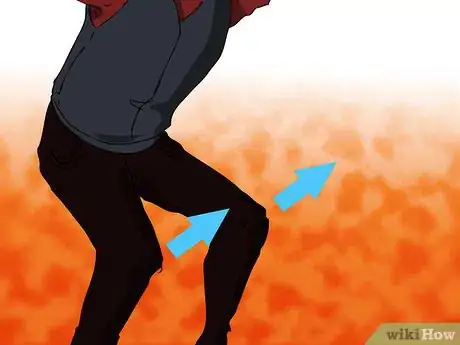

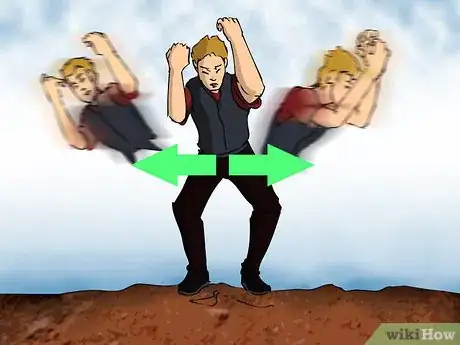


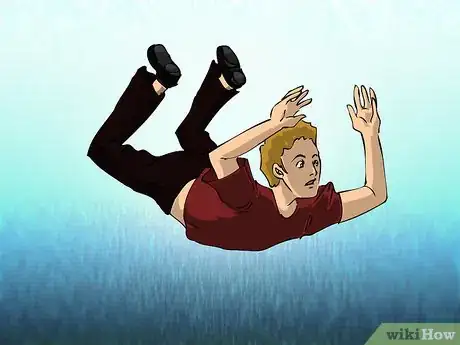


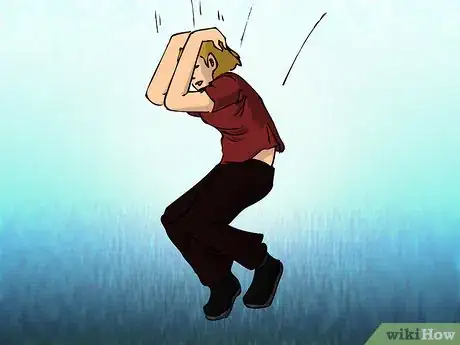




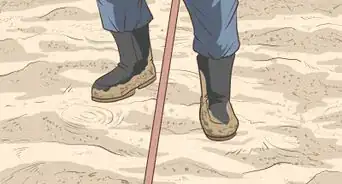



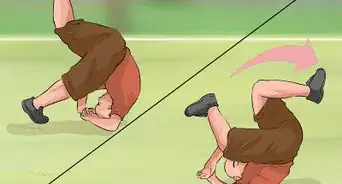










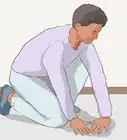






































Medical Disclaimer
The content of this article is not intended to be a substitute for professional medical advice, examination, diagnosis, or treatment. You should always contact your doctor or other qualified healthcare professional before starting, changing, or stopping any kind of health treatment.
Read More...